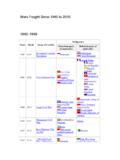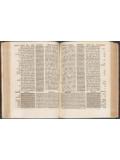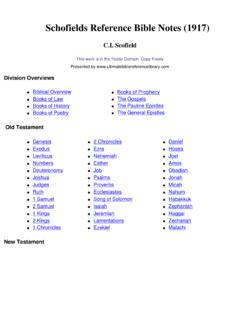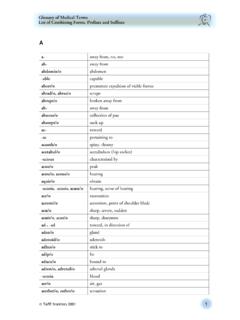Transcription of The Dead Sea Scrolls - Ultimate Bible Reference Library
1 The Dead Sea ScrollsThe Ancient Library of Qumran and Modern ScholarshipThis work comes from the United States Library of CongressThis work is in the Public Domain. Copy Freely Table of Contentsl About this Exhibit l Introduction m The World of the Scrolls m The Dead Sea Region m Scrolls n The Psalms scroll m Artifacts from the Qumran Site n scroll Jar - Textiles - Leather scroll Fastenings m Related Library of Congress Materials l The Qumran Community m The Late Second Temple Period m The Qumran Community m Scrolls n The Phylactery scroll - The Community Rule scroll - The Calendrical Document scroll - The Torah Precepts scroll m Artifacts from the Qumran Site n Phylacteries - Wood - Pottery - Basketry & Cordage - Leather - Stone - Coins m Related Library of Congress Materials l The Qumran Library m The Qumran Library m Scrolls n The Enoch scroll - The Hosea Commentary
2 scroll - The Prayer For King Jonathan scroll - The Leviticus scroll - The Sabbath Sacrifice scroll m Artifacts from the Qumran Site n Pottery Inkwell m Related Library of Congress Materials l Two Thousand Years Later m Two Thousand Years Later m Judaism & Christianity & the Dead Sea Scrolls m Scrolls n The Damascus Document scroll - The War Rule scroll m Related Library of Congress Materials l Conclusion l Bibliographies m Selected Readings m Resource Materials for Teachers l glossary l Exhibit Brochure l Artcle About the Dead Sea scroll Exhibit (Includes a bibliography) l Credits Scrolls From the Dead Sea: The Ancient Library of Qumran and Modern ScholarshipABOUT THIS EXHIBITThe exhibition Scrolls From the Dead Sea: The Ancient Library of Qumran and Modern Scholarship brings before the American people a selection from the Scrolls which have been the subject of intense public interest.
3 Over the years questions have been raised about the Scrolls ' authenticity, about the people who hid them away the the period in which they lived, about the secrets the Scrolls might reveal, and about the intentions of the Scrolls ' custodians in restricting access. The Library 's exhibition describes the historical context of the Scrolls and the Qumran community from whence they may have originated; it also relates the story of their discovery 2,000 years later. In addition, the exhibition encourages a better understanding of the challenges and complexities connected with scroll goals of the " Scrolls from the Dead Sea" exhibition are three fold: to enable visitors to see twelve of the Dead Sea scroll fragments; to promote greater understanding of the turbulent period in which the Dead Sea Scrolls were copied; and to provide some insight into the questions raised and the "mystery" surrounding this great manuscript find.
4 The exhibit has an introductory as well as three main sections: The introductory area presents the Psalms scroll , the largest of the scroll fragments in the exhibition, and touches on the geographical and religious contexts of the period. "The Qumran Community" examines the region in which the Scrolls were found, presents the archaeological materials uncovered at the Qumran site, and explores the nature of the habitation adjacent to the scroll -bearing caves. The "Qumran Library " is a look at the various Scrolls that were discovered in the Dead Sea caves. "Two Thousand Years Later" explores the significance of the Scrolls to modern scholarship and presents some of the questions and controversies that surround them. The storyline for the exhibition includes not only interpretation of the Scrolls , their meaning and significance, it also deals, to the extent it has been explored by scholars, with the history and social realities of the people and the times that produced the Scrolls .
5 Recent publications on the exhibited Scrolls are included throughout the exhibition. Finally, the exhibition presents differing views where they occur. For example, the Qumran excavation is viewed by many as the site of a communal religious sect, probably the Essenes. The exhibition explores this interpretation but also presents entirely different points of view. In the exhibition, (Before the Common Era) and (Common Era) are alternate designations for and The exhibition contains other words, terms , and references that may need definition or explanation. Such terms are explained the first time they occur in the exhibition. This online exhibit includes a full glossary of such terms as well as the exhibit brochure. Go to the Next Section of Scrolls from the Dead Sea Table of Contents Scrolls From the Dead Sea: The Ancient Library of Qumran and Modern ScholarshipTHE WORLD OF THE SCROLLSIn 1947, young Bedouin shepherds, searching for a stray goat in the Judean Desert, entered a long-untouched cave and found jars filled with ancient Scrolls .
6 That initial discovery by the Bedouins yielded seven Scrolls and began a search that lasted nearly a decade and eventually produced thousands of scroll fragments from eleven caves. During those same years, archaeologists searching for a habitation close to the caves that might help identify the people who deposited the Scrolls , excavated the Qumran ruin, a complex of structures located on a barren terrace between the cliffs where the caves are found and the Dead Sea. Within a fairly short time after their discovery, historical, paleographic, and linguistic evidence, as well as carbon-14 dating, established that the Scrolls and the Qumran ruin dated from the third century to 68 They were indeed ancient! Coming from the late Second Temple Period, a time when Jesus of Nazareth lived, they are older than any other surviving manuscripts of the Hebrew Scriptures by almost one thousand years.
7 Since their discovery nearly half a century ago, the Scrolls and the identity of the nearby settlement have been the object of great scholarly and public interest, as well as heated debate and controversy. Why were the Scrolls hidden in the caves? Who placed them there? Who lived in Qumran? Were its inhabitants responsible for the Scrolls and their presence in the caves? Of what significance are the Scrolls to Judaism and Christianity? This exhibition presents twelve Dead Sea scroll fragments and archaeological artifacts courtesy of the Israel Antiquities Authority as well as supplementary materials from the Library of Congress. It is designed to retell the story of the Scrolls ' discovery; explore their archaeological and historical context; introduce the Scrolls themselves; explore the various theories concerning the nature of the Qumran community; and examine some of the challenges facing modern researchers as they struggle to reconstruct the Scrolls from the tens of thousands of fragments that remain.
8 Go to the Next Section of Scrolls from the Dead Sea Table of Contents Scrolls From the Dead Sea: The Ancient Library of Qumran and Modern ScholarshipTHE DEAD SEAThe Dead Sea is located in Israel and Jordan, about 15 miles east of Jerusalem. It is extremely deep (averaging about 1,000 feet), salty (some parts containing the highest amount of salts possible), and the lowest body of water in the world. The Dead Sea is supplied by a number of smaller streams, springs, and the Jordan River. Because of its low elevation and its position in a deep basin, the climate of the Dead Sea area is unusual. Its very high evaporation does produce a haze yet its atmospheric humidity is low. Adjacent areas to it are very arid and favorable for the preservation of materials like the Dead Sea Scrolls . The Bible 's description, in Genesis 19, of a destructive earthquake near the Dead Sea area during the time of Abraham is borne out by archaeological and historic investigation.
9 While no evidence remains of the five cities of the plain (Zeboim, Admah, Bela or Zoar, Sodom, and Gomorrah) their sites are believed to be beneath the waters at the southern end of the sea. Archaeological sites near the Dead Sea include Masada, Ein Gedi, and Qumran (where the Dead Sea Scrolls were found). Map of the Dead Sea Region Go to the Next Section of Scrolls from the Dead Sea Table of Contents Scrolls From the Dead Sea: The Ancient Library of Qumran and Modern ScholarshipINTRODUCTION: SCROLLSThis scroll fragment was displayed in the exhibit at the Library of Congress, May-August 1993. It was provided courtesy of the Israel Antiquities Authority. The exhibit caption and translation provide background on the fragment and its relationship with the other Dead Sea Scrolls , the Qumran Community, and its Library .
10 The Psalms ScrollThe Psalms scroll (black & white) The Psalms scroll (color) The Psalms scroll (color, with transcription) Translation of the Psalms scroll Tehillim11 QPsParchmentCopied ca. 30 - 50 cm (7 1/4 in.), length 86 cm (33 3/4 in.)Courtesy of the Israel Antiquities Authority (5)This impressive scroll is a collection of psalms and hymns, comprising parts of forty-one biblical psalms (chiefly form chapters 101-50), in non-canonical sequence and with variations in detail. It also presents previously unknown hymns, as well as a prose passage about the psalms composed by King David. One of the longer texts to be found at Qumran, the manuscript was found in 1956 in Cave 11 and unrolled in 1961. Its surface is the thickest of any of the Scrolls --it may be of calfskin rather than sheepskin, which was the more common writing material at Qumran.




